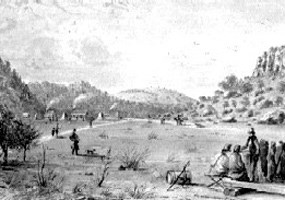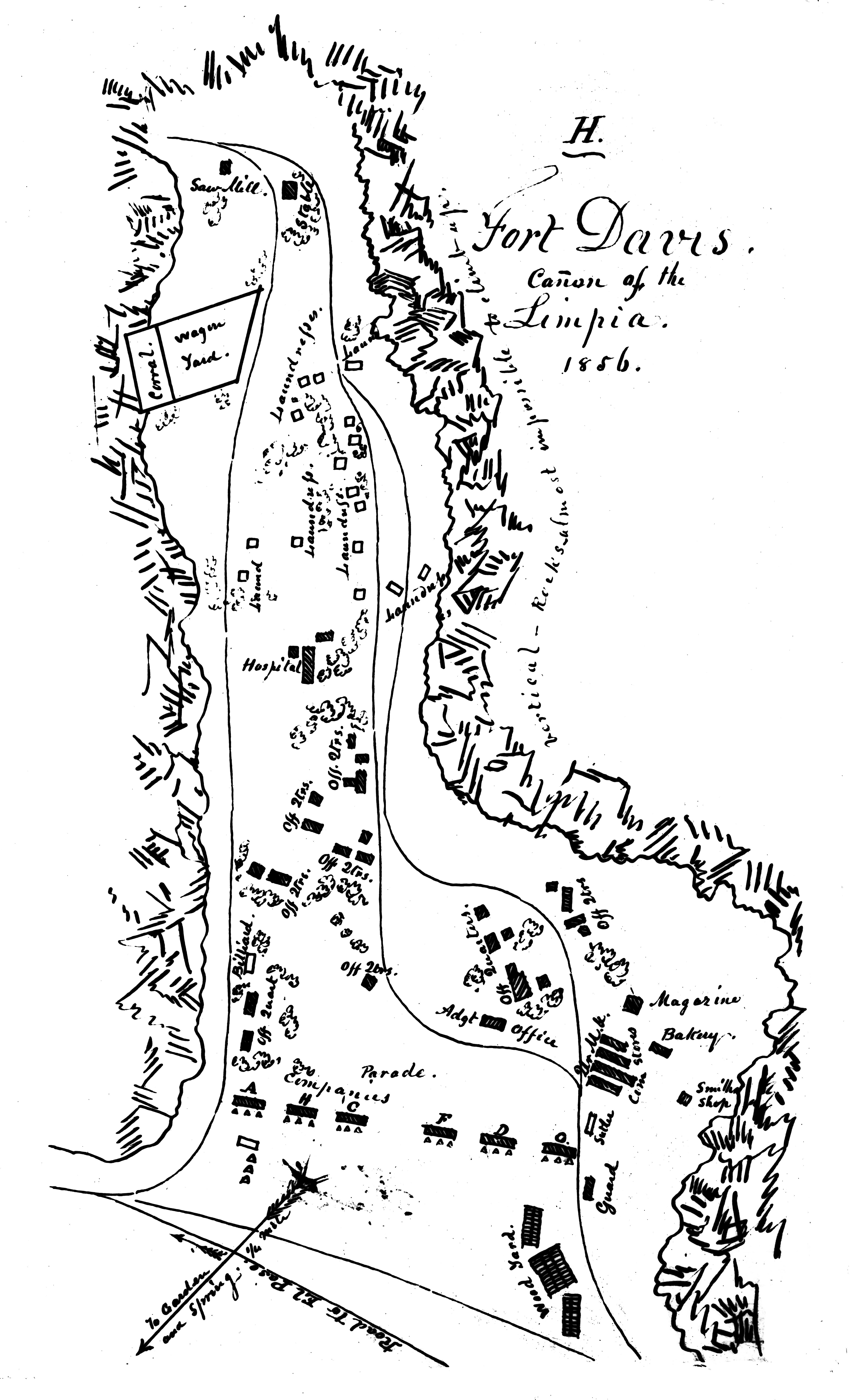
On October 23, 1854, General Persifor F. Smith, in command of the Department of Texas, issued the order officially establishing Fort Davis. Smith, who had personally selected the site, named it in honor of the Secretary of War, Jefferson Davis. Commanded by Lieutenant Colonel Washington Seawell, the fort was manned by companies of the Eighth U. S. Infantry, which served at the fort from 1854 until April of 1861. The site for the first Fort Davis was believed to be on land owned by the State of Texas, which could either be leased or purchased for use by the U. S. Army. Soon after the location was selected, however, it was learned the land was owned by a San Antonio surveyor named John James. Immediately, the army took steps to lease the land from James. In October 1855, Second Lieutenant Zenas R. Bliss, Eighth U. S. Infantry, arrived at Fort Davis seventeen days after boarding the westbound stage in San Antonio. "The Post was the most beautifully situated of any that I have ever seen. It was in a narrow canyon with perpendicular sides, the walls of which were about 200 feet in height," the young officer later wrote. The necessity for the post, located some 400 miles from San Antonio and 200 miles from Franklin (present-day El Paso), stemmed from demands for protection on the San Antonio-El Paso Road. A major link along the most southern route to California, the road experienced an upsurge of travel in the early 1850s following the discovery of gold in California. As travel along the road increased, so did Comanche, Kiowa, and Apache raids into Mexico. Emigrants, mail carriers and merchants journeyed in constant fear of the raiding warriors who traveled between Mexico and their homelands to the north. Despite its picturesque terrain, the buildings were uncomfortable and difficult to keep warm. "I remember once in a snow storm the snow blew under my bed . . . and it stayed there several days without melting," wrote Lieutenant Bliss. In 1856, six stone barracks with thatched roofs and flagstone floors replaced inadequate enlisted men’s quarters. Along with the bakery, blacksmith shop, and a warehouse, they were the only substantial structures of the first fort. In 1855-1856, Fort Davis boasted over 400 enlisted men and officers. At the time, it was deemed one of the largest posts on the frontier. Yet, in spite of its size, the task of insuring the safety of those traveling on the San Antonio-El Paso Road proved an almost insurmountable task for the infantrymen. Troops from the post engaged in numerous scouting patrols and expeditions, but encounters with Comanches and Apaches were rare. The ever-increasing traffic on the road proved to be inviting prey for the elusive Indians, and the foot soldiers had little success in exerting control over them. In attempting to adequately supply Fort Davis and other southwestern posts, the army in 1855 embarked on an unusual experiment involving the importation of camels from the Middle East. Within the year, seventy-four camels were brought to Texas. Initially, a third of this number were outfitted to accompany Lieutenant Edward Beale as he surveyed a wagon road to Arizona. Beale and the camels passed through Fort Davis in the summer of 1857. Other camel expeditions followed in 1859 and 1860, with Fort Davis serving as a base of operations.The camels proved to be superior ‘beasts of burden’ as they were able to carry heavier loads than horses, mules, or oxen, and they required less water and food. The ‘camel experiments,’ which were championed by Jefferson Davis, however, were short-lived. Although successful, they were ultimately forgotten with the onset of the Civil War. Following the outbreak of the Civil War in the Spring of 1861, federal troops withdrew from Fort Davis, and companies of the Second Texas Mounted Rifles became its new occupants. Confederates served at the post for a little over a year while it functioned as a crucial supply depot for General Henry H. Sibley's New Mexico Campaign. In August of 1862, Union forces regained control of the post but did not occupy it. Fort Davis remained abandoned from September of 1862 until June of 1867. When federal troops reestablished the post, they chose to move the location to the flat area east of the canyon. This is the site of the second and present fort and where Lieutenant Colonel Seawell wanted the first fort constructed. The first Fort Davis served as a retreat for thousands of emigrants, freighters, and travelers during the decade preceding the Civil War. It provided protection for the U. S. Mail and saw the establishment of a number of stage stations and military posts in the region, including Fort Stockton and Fort Quitman. It was also an influencing factor in 1859 for the Butterfield Overland Mail to change its route to El Paso. The new route came through Fort Davis instead of following the road through the Guadalupe Mountains. Although the post did little to reduce Indian activity in western Texas, its presence encouraged travel on the San Antonio-El Paso Road and settlement in the Trans-Pecos region. 
|
Last updated: February 4, 2018
